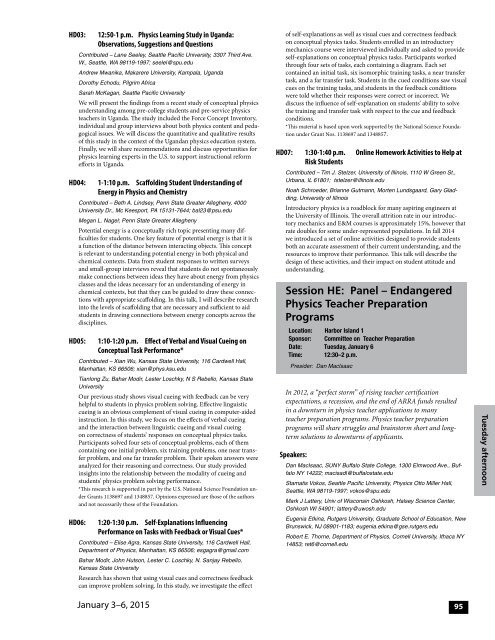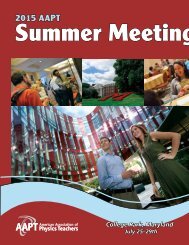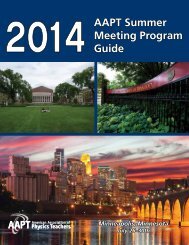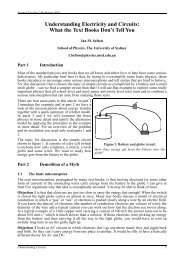final-program-12-23-14-3
final-program-12-23-14-3
final-program-12-23-14-3
Create successful ePaper yourself
Turn your PDF publications into a flip-book with our unique Google optimized e-Paper software.
HD03: <strong>12</strong>:50-1 p.m. Physics Learning Study in Uganda:<br />
Observations, Suggestions and Questions<br />
Contributed – Lane Seeley, Seattle Pacific University, 3307 Third Ave.<br />
W., Seattle, WA 98119-1997; seelel@spu.edu<br />
Andrew Mwanika, Makarere University, Kampala, Uganda<br />
Dorothy Echodu, Pilgrim Africa<br />
Sarah McKagan, Seattle Pacific University<br />
We will present the findings from a recent study of conceptual physics<br />
understanding among pre-college students and pre-service physics<br />
teachers in Uganda. The study included the Force Concept Inventory,<br />
individual and group interviews about both physics content and pedagogical<br />
issues. We will discuss the quantitative and qualitative results<br />
of this study in the context of the Ugandan physics education system.<br />
Finally, we will share recommendations and discuss opportunities for<br />
physics learning experts in the U.S. to support instructional reform<br />
efforts in Uganda.<br />
HD04: 1-1:10 p.m. Scaffolding Student Understanding of<br />
Energy in Physics and Chemistry<br />
Contributed – Beth A. Lindsey, Penn State Greater Allegheny, 4000<br />
University Dr., Mc Keesport, PA 15131-7644; bal<strong>23</strong>@psu.edu<br />
Megan L. Nagel; Penn State Greater Allegheny<br />
Potential energy is a conceptually rich topic presenting many difficulties<br />
for students. One key feature of potential energy is that it is<br />
a function of the distance between interacting objects. This concept<br />
is relevant to understanding potential energy in both physical and<br />
chemical contexts. Data from student responses to written surveys<br />
and small-group interviews reveal that students do not spontaneously<br />
make connections between ideas they have about energy from physics<br />
classes and the ideas necessary for an understanding of energy in<br />
chemical contexts, but that they can be guided to draw these connections<br />
with appropriate scaffolding. In this talk, I will describe research<br />
into the levels of scaffolding that are necessary and sufficient to aid<br />
students in drawing connections between energy concepts across the<br />
disciplines.<br />
HD05: 1:10-1:20 p.m. Effect of Verbal and Visual Cueing on<br />
Conceptual Task Performance*<br />
Contributed – Xian Wu, Kansas State University, 116 Cardwell Hall,<br />
Manhattan, KS 66506; xian@phys.ksu.edu<br />
Tianlong Zu, Bahar Modir, Lester Loschky, N S Rebello, Kansas State<br />
University<br />
Our previous study shows visual cueing with feedback can be very<br />
helpful to students in physics problem solving. Effective linguistic<br />
cueing is an obvious complement of visual cueing in computer-aided<br />
instruction. In this study, we focus on the effects of verbal cueing<br />
and the interaction between linguistic cueing and visual cueing<br />
on correctness of students’ responses on conceptual physics tasks.<br />
Participants solved four sets of conceptual problems, each of them<br />
containing one initial problem, six training problems, one near transfer<br />
problem, and one far transfer problem. Their spoken answers were<br />
analyzed for their reasoning and correctness. Our study provided<br />
insights into the relationship between the modality of cueing and<br />
students’ physics problem solving performance.<br />
*This research is supported in part by the U.S. National Science Foundation under<br />
Grants 1138697 and 1348857. Opinions expressed are those of the authors<br />
and not necessarily those of the Foundation.<br />
HD06: 1:20-1:30 p.m. Self-Explanations Influencing<br />
Performance on Tasks with Feedback or Visual Cues*<br />
Contributed – Elise Agra, Kansas State University, 116 Cardwell Hall,<br />
Department of Physics, Manhattan, KS 66506; esgagra@gmail.com<br />
Bahar Modir, John Hutson, Lester C. Loschky, N. Sanjay Rebello,<br />
Kansas State University<br />
Research has shown that using visual cues and correctness feedback<br />
can improve problem solving. In this study, we investigate the effect<br />
of self-explanations as well as visual cues and correctness feedback<br />
on conceptual physics tasks. Students enrolled in an introductory<br />
mechanics course were interviewed individually and asked to provide<br />
self-explanations on conceptual physics tasks. Participants worked<br />
through four sets of tasks, each containing a diagram. Each set<br />
contained an initial task, six isomorphic training tasks, a near transfer<br />
task, and a far transfer task. Students in the cued conditions saw visual<br />
cues on the training tasks, and students in the feedback conditions<br />
were told whether their responses were correct or incorrect. We<br />
discuss the influence of self-explanation on students’ ability to solve<br />
the training and transfer task with respect to the cue and feedback<br />
conditions.<br />
*This material is based upon work supported by the National Science Foundation<br />
under Grant Nos. 1138697 and 1348857.<br />
HD07: 1:30-1:40 p.m. Online Homework Activities to Help at<br />
Risk Students<br />
Contributed – Tim J. Stelzer, University of Illinois, 1110 W Green St.,<br />
Urbana, IL 61801; tstelzer@illinois.edu<br />
Noah Schroeder, Brianne Gutmann, Morten Lundsgaard, Gary Gladding,<br />
University of Illinois<br />
Introductory physics is a roadblock for many aspiring engineers at<br />
the University of Illinois. The overall attrition rate in our introductory<br />
mechanics and E&M courses is approximately 15%, however that<br />
rate doubles for some under-represented populations. In fall 20<strong>14</strong><br />
we introduced a set of online activities designed to provide students<br />
both an accurate assessment of their current understanding, and the<br />
resources to improve their performance. This talk will describe the<br />
design of these activities, and their impact on student attitude and<br />
understanding.<br />
Session HE: Panel – Endangered<br />
Physics Teacher Preparation<br />
Programs<br />
Location: Harbor Island 1<br />
Sponsor: Committee on Teacher Preparation<br />
Date: Tuesday, January 6<br />
Time: <strong>12</strong>:30–2 p.m.<br />
Presider: Dan MacIsaac<br />
In 20<strong>12</strong>, a “perfect storm” of rising teacher certification<br />
expectations, a recession, and the end of ARRA funds resulted<br />
in a downturn in physics teacher applications to many<br />
teacher preparation <strong>program</strong>s. Physics teacher preparation<br />
<strong>program</strong>s will share struggles and brainstorm short and longterm<br />
solutions to downturns of applicants.<br />
Speakers:<br />
Dan MacIsaac, SUNY Buffalo State College, 1300 Elmwood Ave., Buffalo<br />
NY <strong>14</strong>222; macisadl@buffalostate.edu<br />
Stamatis Vokos, Seattle Pacific University, Physics Otto Miller Hall,<br />
Seattle, WA 98119-1997; vokos@spu.edu<br />
Mark J Lattery, Univ of Wisconsin Oshkosh, Halsey Science Center,<br />
Oshkosh WI 54901; lattery@uwosh.edu<br />
Eugenia Etkina, Rutgers University, Graduate School of Education, New<br />
Brunswick, NJ 08901-1183; eugenia.etkina@gse.rutgers.edu<br />
Robert E. Thorne, Department of Physics, Cornell University, Ithaca NY<br />
<strong>14</strong>853; ret6@cornell.edu<br />
Tuesday afternoon<br />
January 3–6, 2015<br />
95






